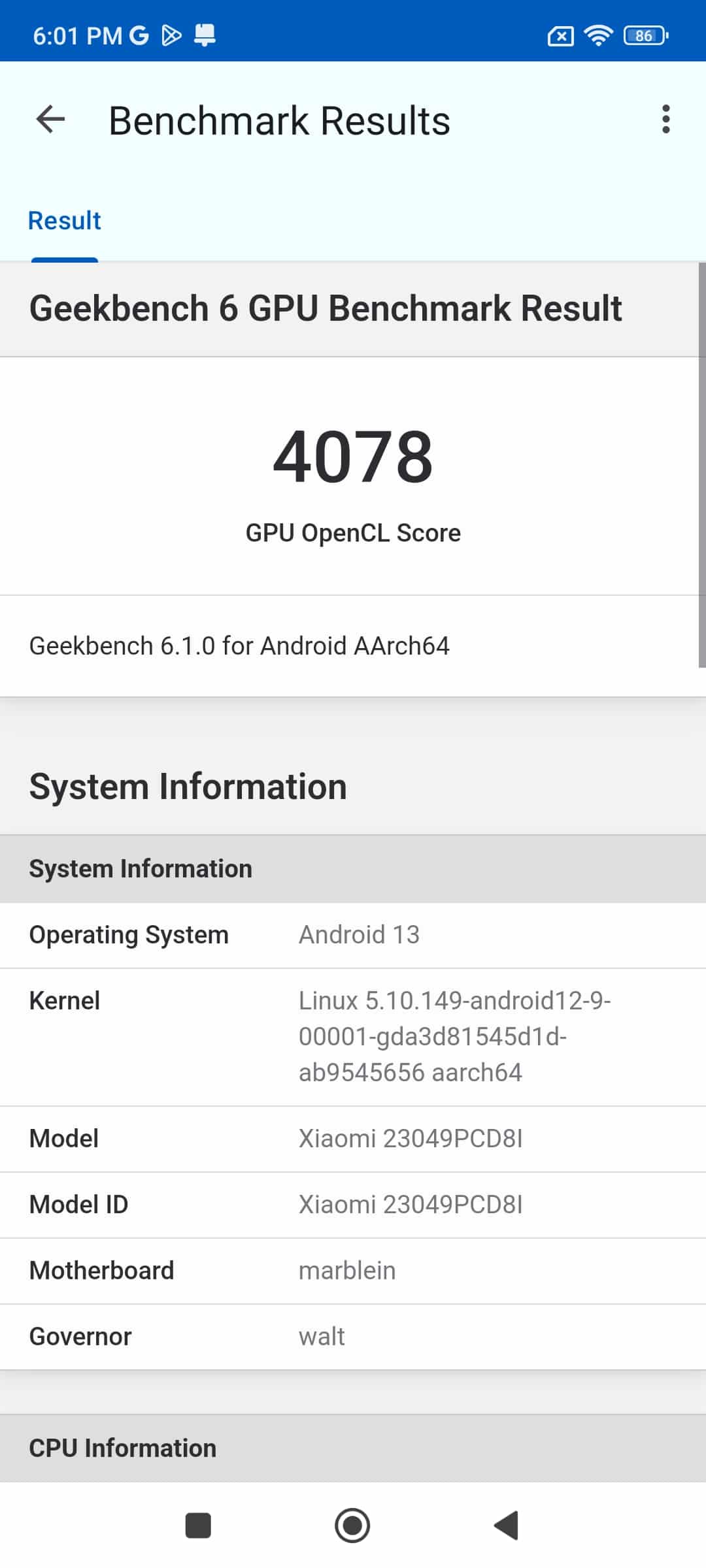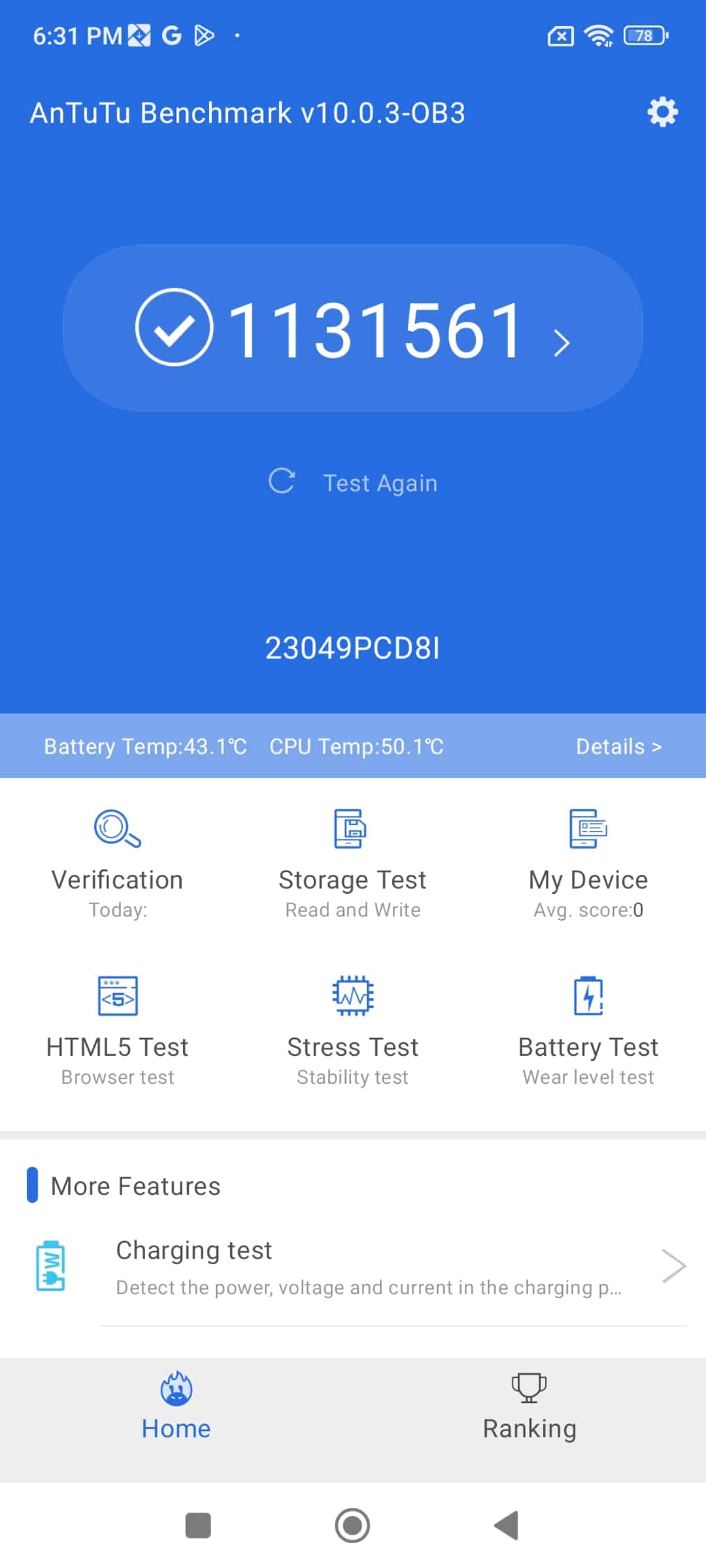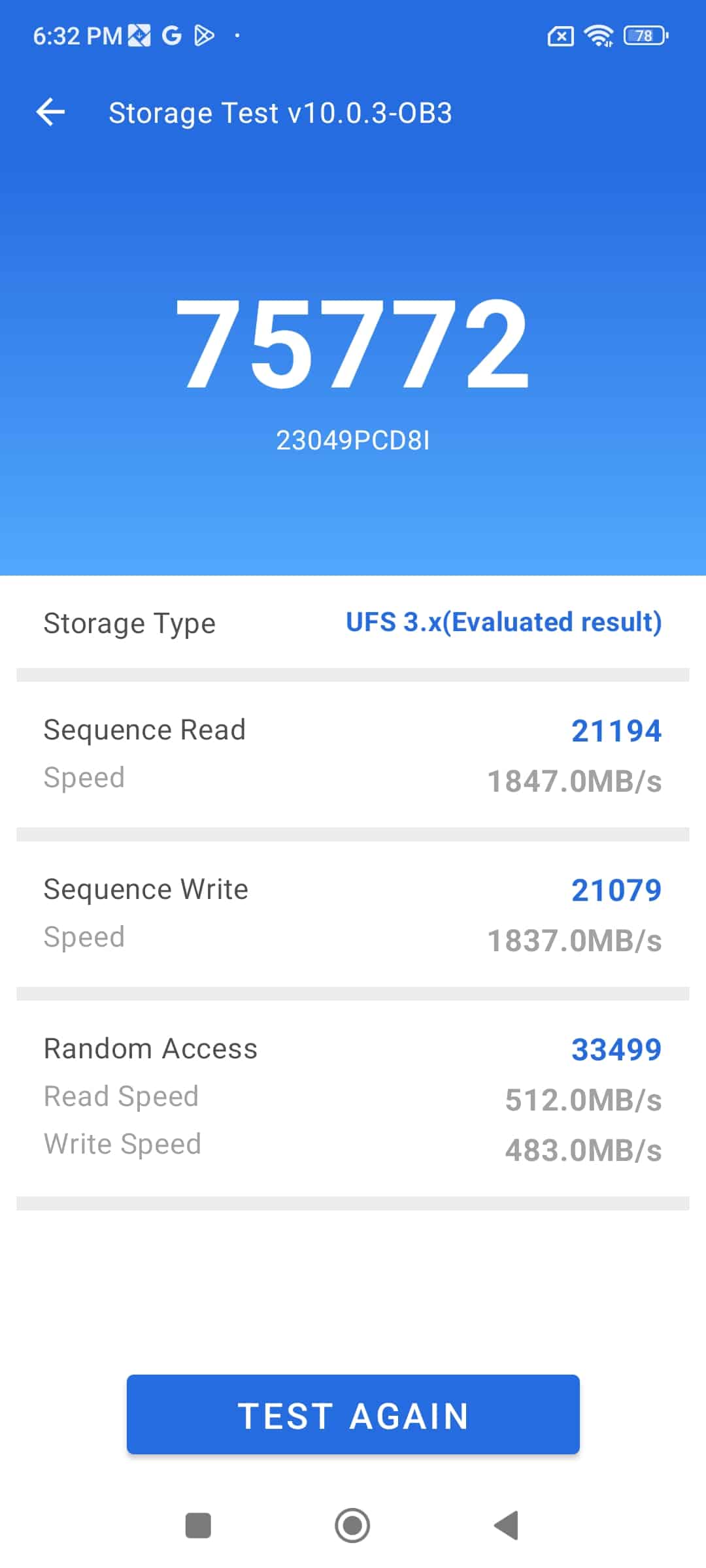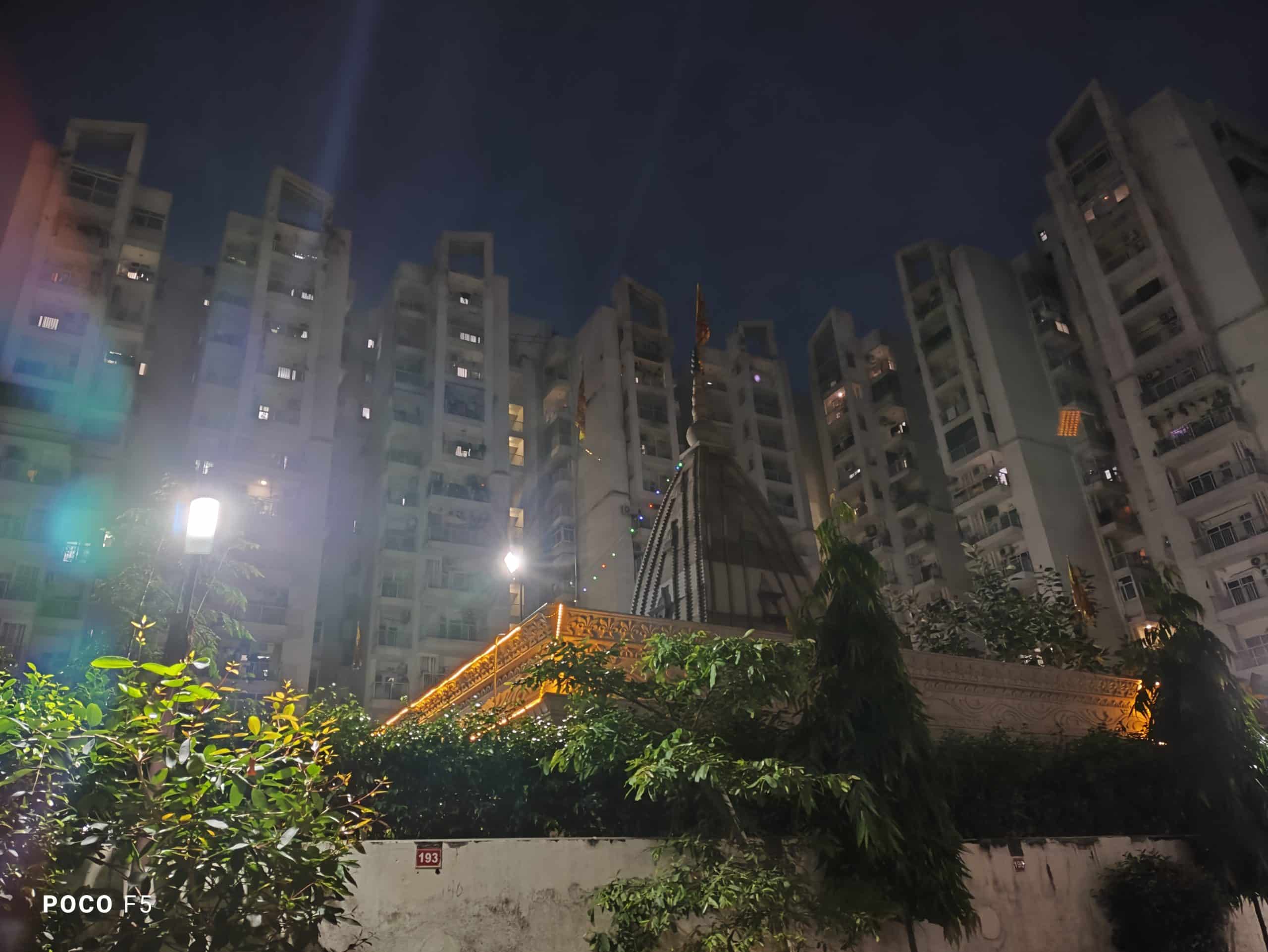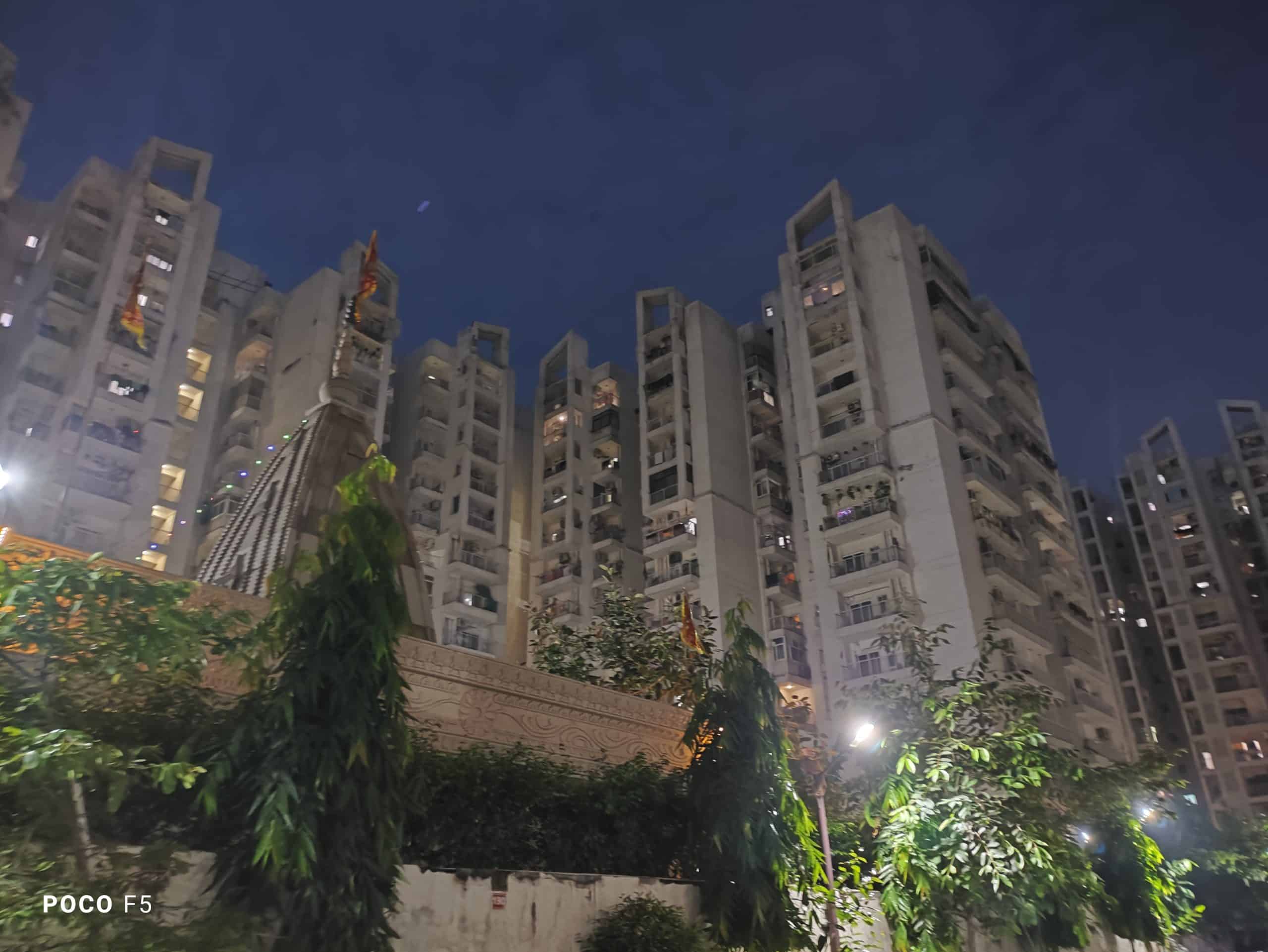Highlight
- The Poco F5 5G sports a 6.67-inch AMOLED display with a Qualcomm Snapdragon 7 Plus Gen 2 processor and 8 GB RAM to ensure smooth performance and effortless multitasking.
- Capture stunning photos with the triple rear camera setup, featuring a 64 MP primary lens, an 8 MP ultra-wide lens, and a 2 MP depth sensor. The 16 MP front camera is perfect for high-quality selfies.
- With its 5000 mAh battery, the Poco F5 5G provides long-lasting usage, and it runs on the latest Android v13 operating system for an enhanced user experience.
- In this blog, we are sharing our in-depth Poco F5 review and taking a closer look at its features and performance.
The recently launched Poco F5 5G, at first glance, will instantly give you flashbacks of Poco F1, the first Poco smartphone to release in India in 2018.
Poco, initially launched as a sub-brand from Xiaomi, has since then not only became an independent company but has also managed to keep its mid-range smartphone line-up constantly interesting.
Now, it seems with Poco F5, the brand is trying to checking every box in the checklist to ensure a true flagship experience.
In this blog, we will be taking a closer look at the Poco F5 to see if it lives up to its marketing slogan “the origin of speed.”
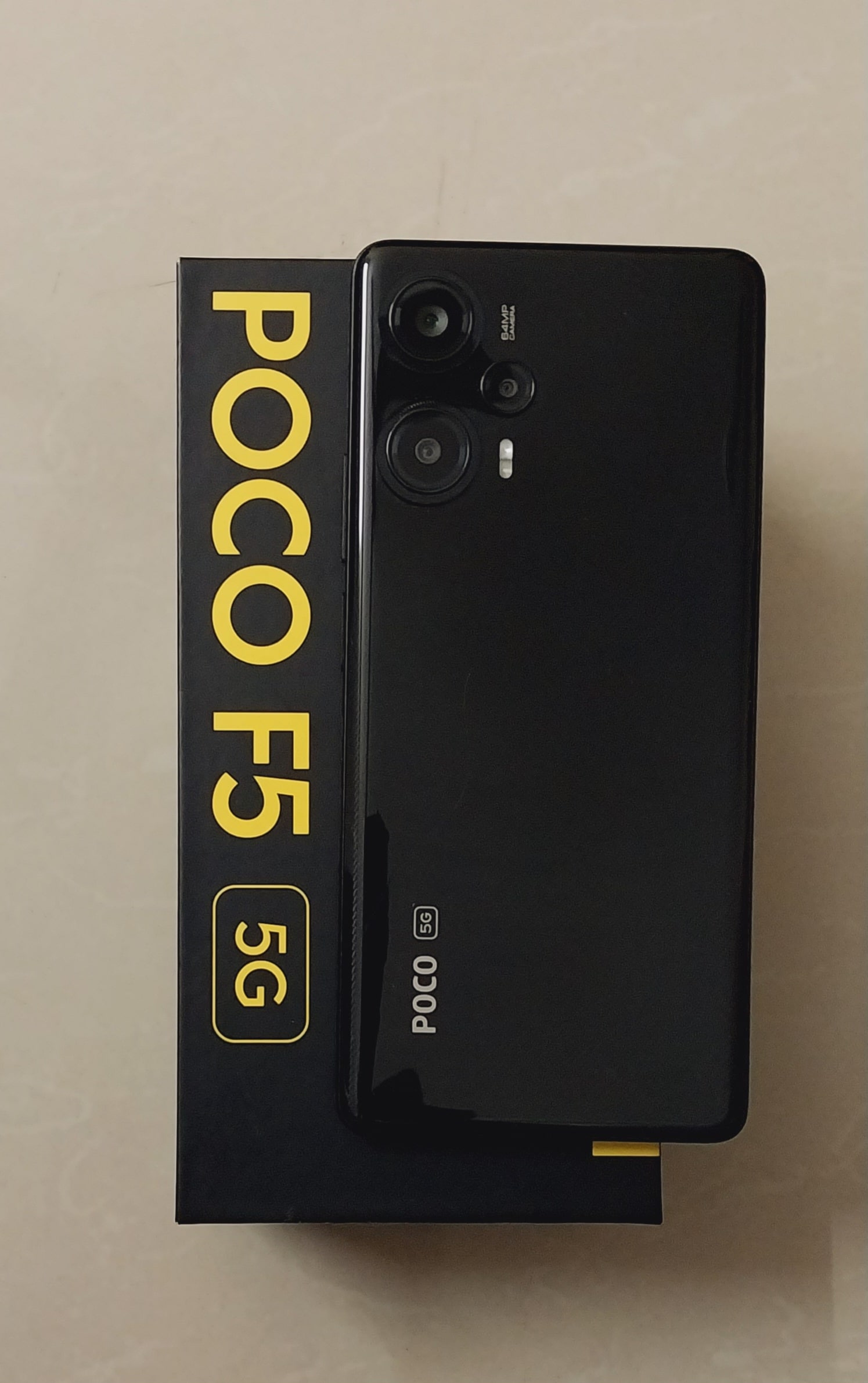
The Poco F5 5G features a large 6.67-inch AMOLED display with 120Hz refresh rate, which promises to deliver an immersive viewing experience with vibrant colors and sharp details.
Under the hood, the Qualcomm Snapdragon 7 Plus Gen 2 processor ensures smooth and lag-free performance. It handles multitasking effortlessly, thanks to its 8 GB RAM and 256 GB of internal storage.
The latest Poco smartphone is also impressive in camera department. It boasts a triple rear camera setup, including a 64-megapixel primary lens, an 8-megapixel ultra-wide lens, and a 2-megapixel depth sensor.
The camera system seems capable of shooting landscapes, portraits, or close-ups, while delivering exceptional clarity and detail.
On the front, Poco has included a 16-megapixel selfie camera to ensure that your self-portraits are on point.
Powering the Poco F5 is a robust 5000 mAh battery, providing you with all-day usage without needing frequent recharging. It also comes with a 67W turbo charger in the box to make sure the device keeps up with your active lifestyle.
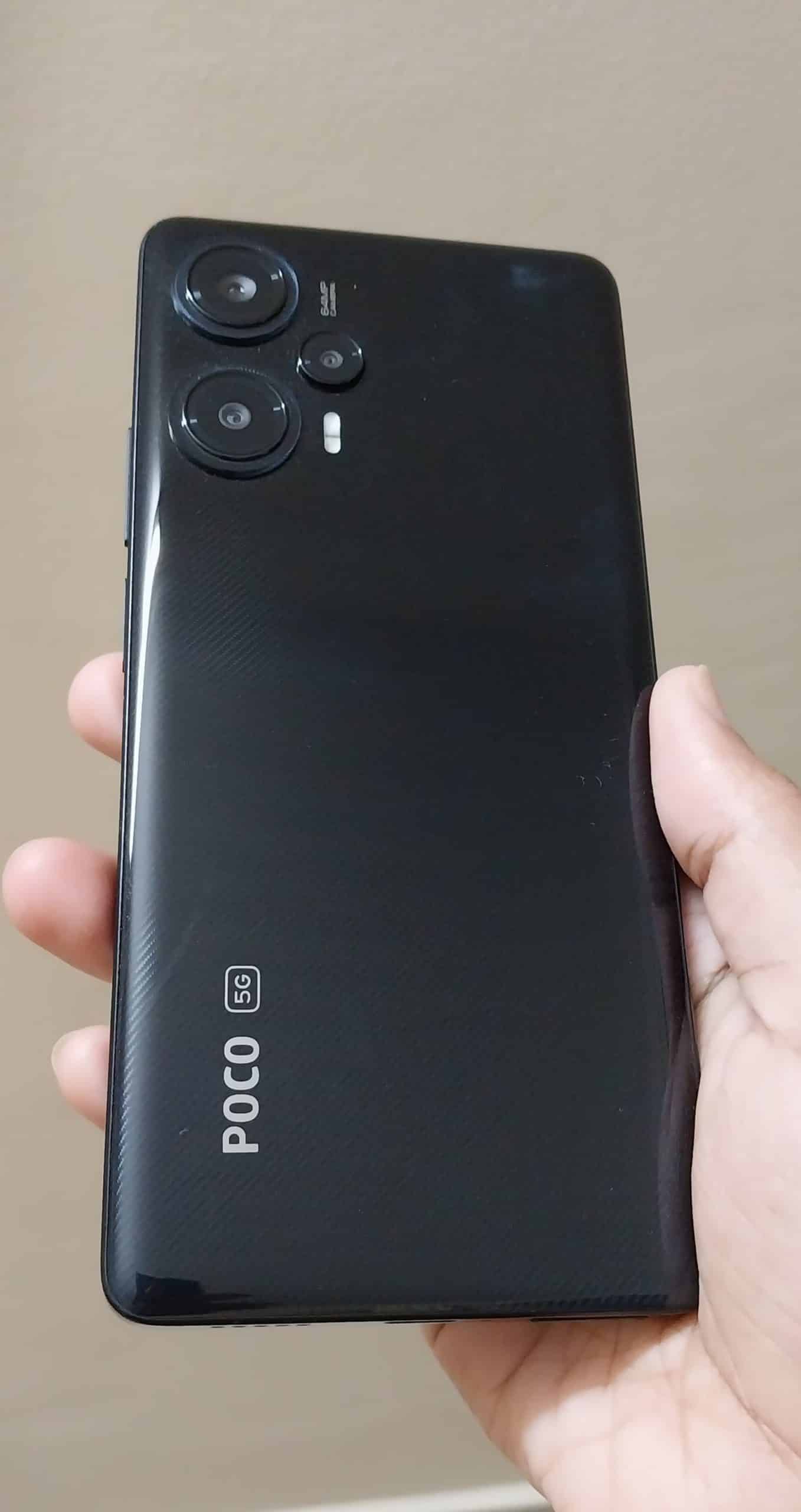
Running on the latest Android v13 operating system, this smartphone is 5G enabled along with other connectivity options such as 4G, Bluetooth v5.3, Wi-Fi and Dual active SIM slots for connectivity.
POCO F5 price in India starts from Rs. 29,999 for the base variant and it is available in Carbon Black, Sandstorm White, Electric Blue colour variants.
So, we have managed to spend a couple of days with Poco F5 and we are sharing our in-depth review of the latest Poco smartphone to see how this phones stack up to the expectations and whether it is worth your money.
However, before anything else, here’s a quick look at the key features and pros & cons of the device.
Poco F5 – Key Features
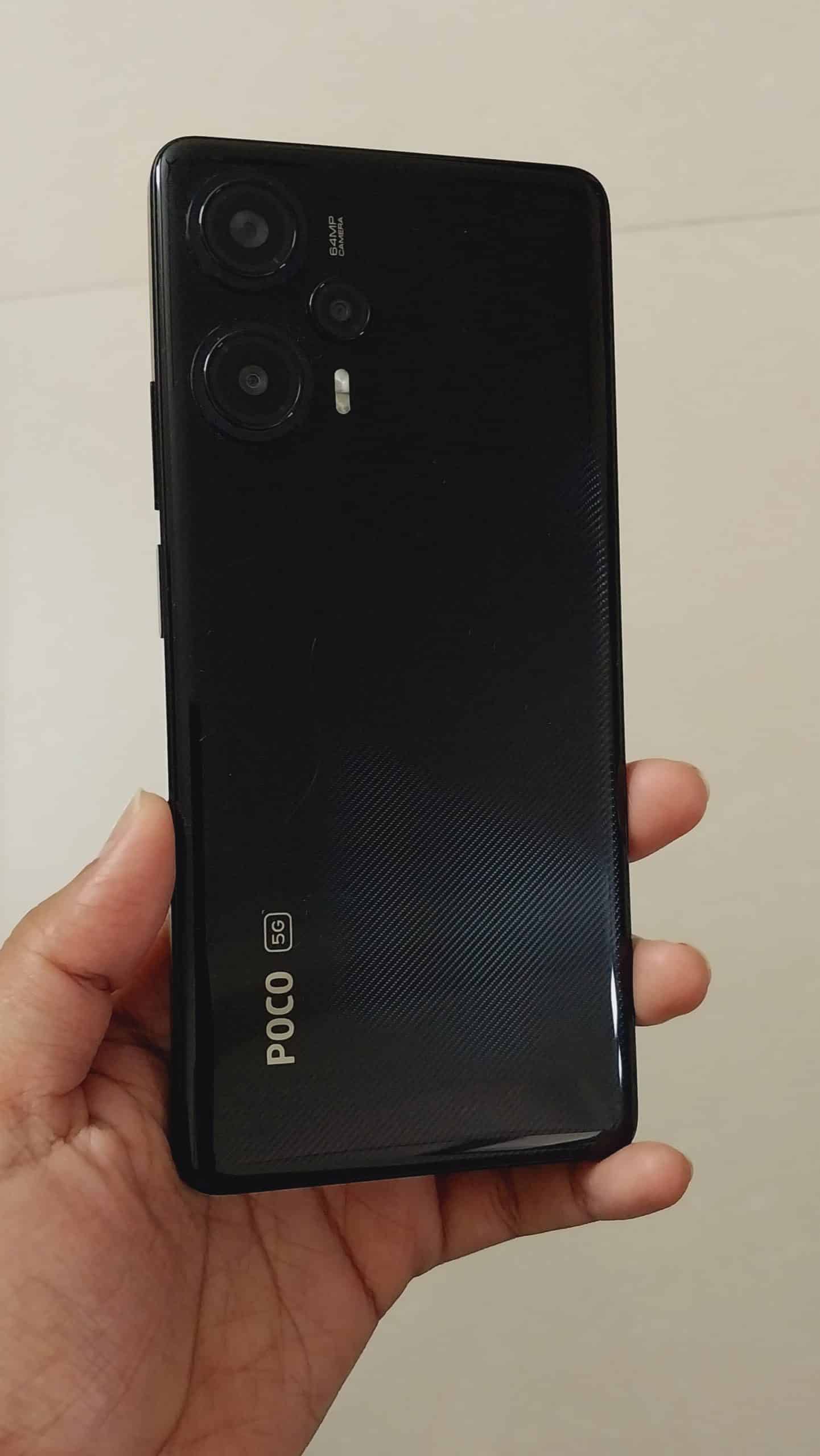
- 67-inch AMOLED Display
- Qualcomm Snapdragon 7 Plus Gen 2 Processor
- 8 GB RAM
- 256 GB Internal Storage
- 64 MP + 8 MP + 2 MP Triple Rear Camera
- 16 MP Front Camera
- 5000 mAh Battery
- Android v13 OS
Poco F5 – Pros & Cons
| Pros | Cons |
| ● Flagship performance
● 120Hz Flow AMOLED display ● Good set of speakers ● Effective thermals ● Good Battery Life ● Good benchmark scores |
● Average Design
● Average Camera Performance ● Loaded with Bloatware |
Poco F5 Unboxing
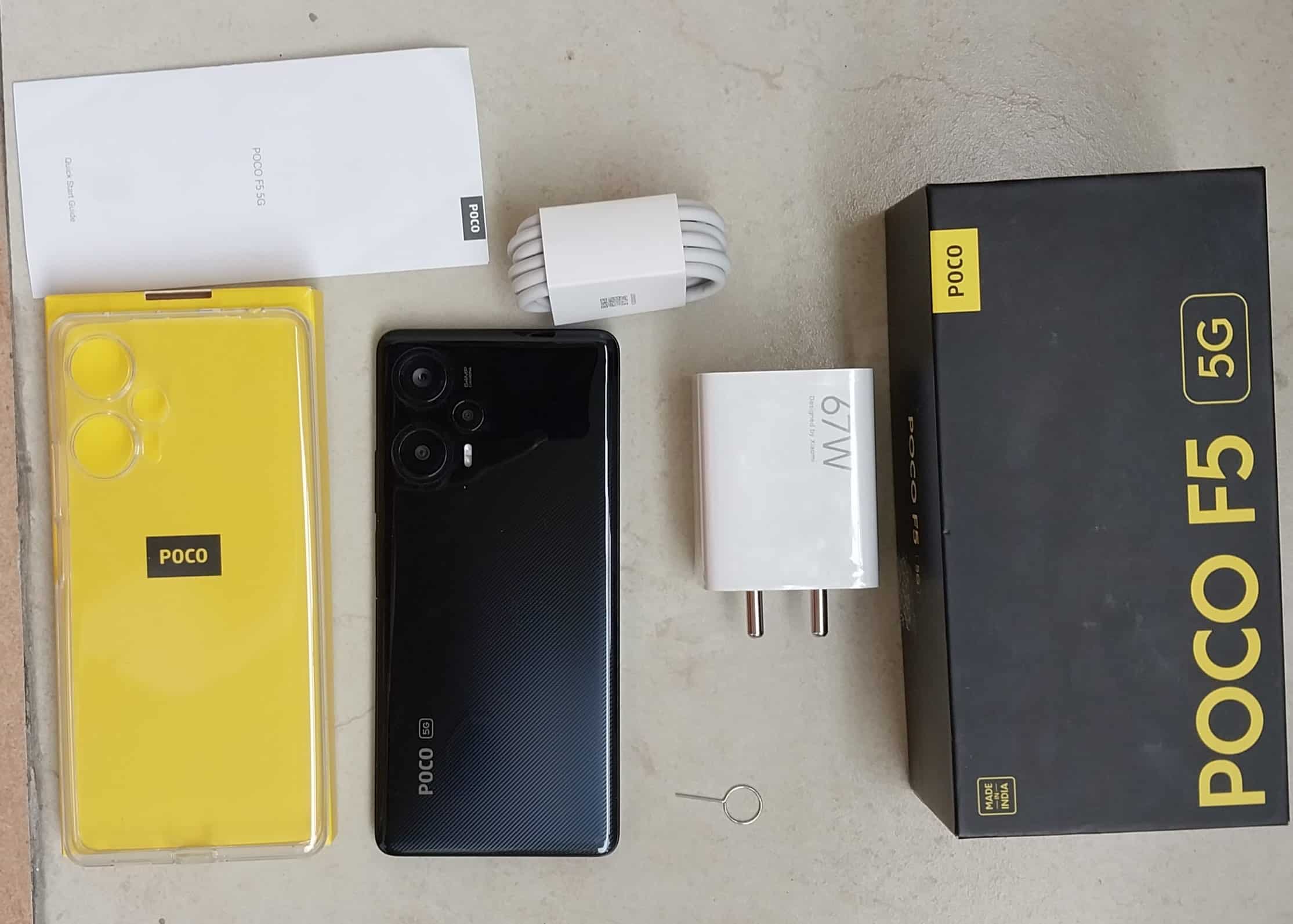
Let’s start from the start and talk about unboxing Poco F5.
As you open the box, you’re greeted with the strikingly yellow paper box with Poco branding stacked right at the top.
Take out the yellow paper box outside and inside you will find the SIM Ejector Tool tucked in of the flaps and then a Quick Start Guide and some other paperwork along with a standard Transparent Soft Case for immediate protection of the device.
Now, keeping the yellow paper box aside, we move on to the other contents of the box as next you find the smartphone itself.
Lifting the smartphone out of the box, you immediately notice its lightweight yet sturdy build, making it comfortable to hold and handle.
The smartphone comes wrapped in a plastic wrap and has a screen protector pre-applied for immediate safety of the device.
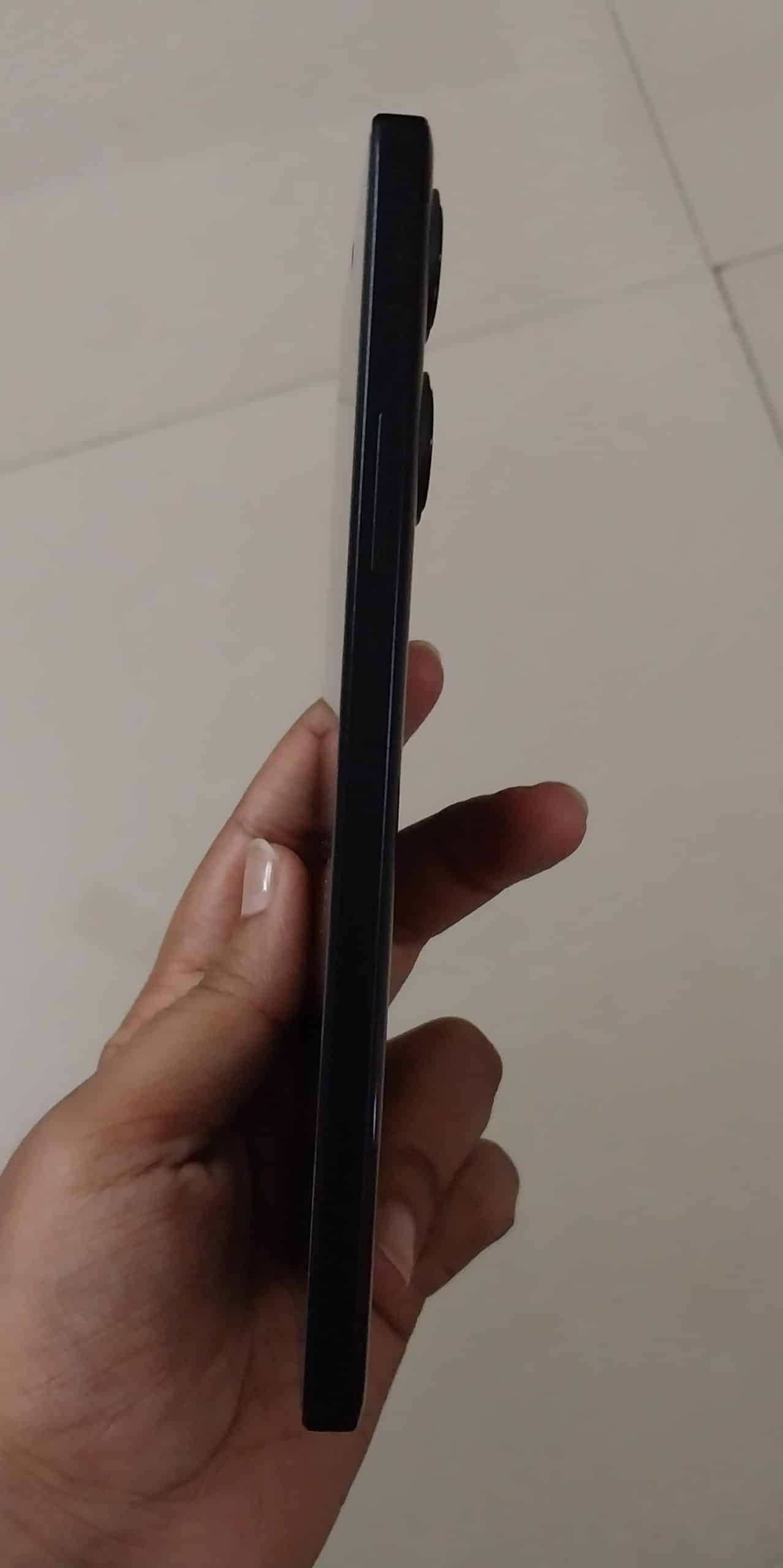
Beneath the smartphone, you’ll find a couple of accessories that are needed to be able to use the device. Poco has included a 67W Turbo Charger design by Xiaomi and USB Type-C cable for fast and convenient charging of the device.
Turning on the device, you’re greeted with a vibrant display that showcases the Poco F5’s colour default wallpaper.
The initial setup process is straightforward, guiding you through the essential configurations, such as language selection, Wi-Fi setup, and fingerprint or facial recognition setup for enhanced security.
Once the setup is complete, you’re ready to explore the features and capabilities of the Poco F5.
It is interesting how brands such as Poco with their mid-range smartphones are still ensuring to include everything the user might need right in the box.
So, before we move on to the device design and other aspects, here’s another quick check on what in-the-box accessories come with Poco F5 –
- POCO F5
- 67W Turbo Charging Adapter
- USB Type-C Cable
- SIM Eject Tool
- Protective Case
- Quick Start Guide
- Warranty Card
- Safety Information
Now, let’s move on to the design of the latest Poco Phone.
Poco F5 – Design
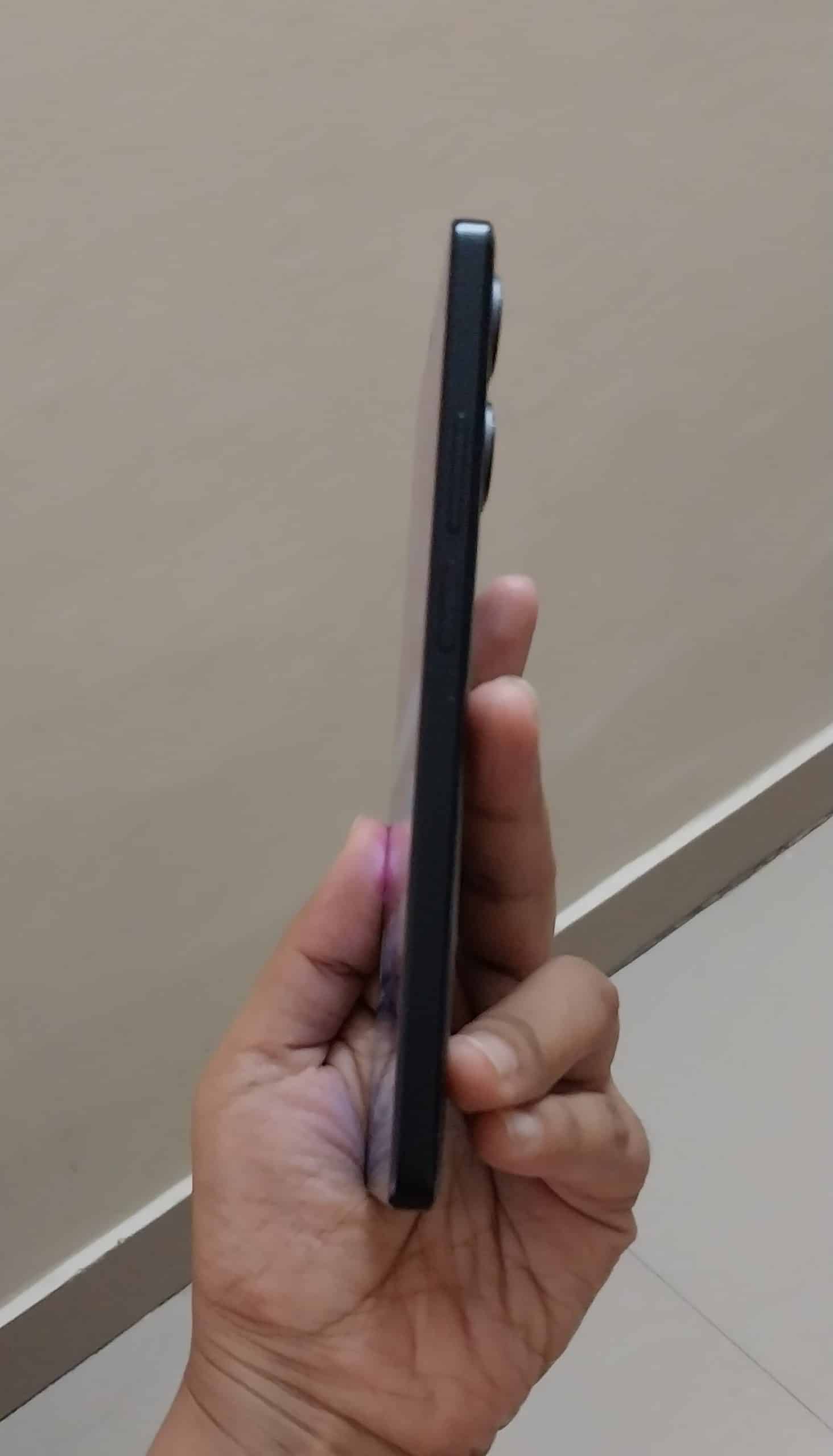
Now, first things first, we must say the first though that came to our mind – the design is too simple.
Now, blame it to the over enthusiastic design innovation that we are getting use to see from smartphone brands in the mid-range segment, but compared to a lot of other prominent competitors, the Poco F5’s design looks very minimalistic to say the least.
The back panel is made out of a high quality polycarbonate material and has quite a unique running Kevlar pattern. It also has an extreme glossy finish that makes it reflective.
But, here’s one thing to know about the back panel – it has a closet finish which makes it very prone to fingerprint smudges. Just after having the phone in our hands for about half-an-hour, the innumerable smudges on the back panel were hard to ignore.
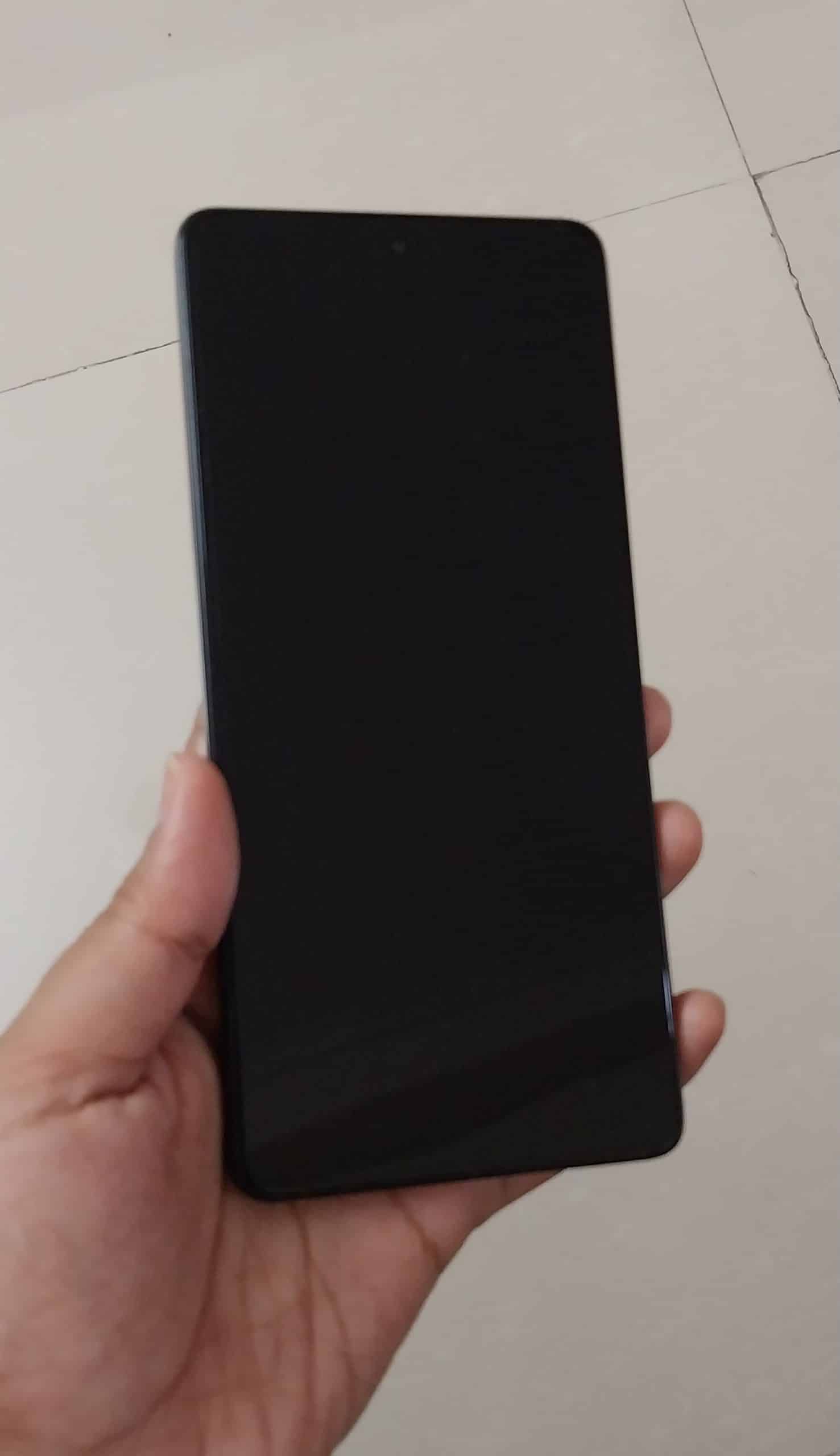
Having said that, the smartphone overall does feel like it is made out of an aluminum material while the sides are made of metal, which overall gives the phone a neat look.
Another positive is that the device is extremely lightweight and thin. It’s only about 7.9mm thick and weighs 180 gms on the scale, making it very comfortable to hold.
We also really like the in-hand feel of the phone. Even though it is a plus size smartphone, it is very easy to grip thanks to the chamfered edges and flat sides.
Also at the back, we can find the Poco branding as well as its triple rear camera setup along with a dual LED flash. On the front, we get a sizeable 6.67 inch display with a punch hole cut out in the middle for its selfie camera.
For buttons and porch, starting on the right side we have the volume rocker and the power button that also works as a fingerprint scanner. Nothing can be found on the left side while we do have a secondary speaker, a secondary microphone, an IR blaster and a 3.5 millimeter headphone jack up top.
Lastly, at the bottom, we have the dual SIM card tray, primary microphone speaker grilles and the USB type-c port.
Moreover, it also has IP53 Splash resistant rating which is also a plus.
Poco F5 – Display, Sound and Multimedia Experience

The Poco F5 boasts an impressive 6.67-inch FHD+ Flow AMOLED DotDisplay that is design to set standards in visual excellence.
The Full HD Plus resolution of 2400 x 1080 ensures sharp details and vibrant visuals that bring your favorite movies, games, and photos to life.
The 120Hz refresh rate ensures smooth scrolling, seamless animations, and an overall more responsive touch experience.
Combined with a touch sampling rate of 240Hz, every interaction on the screen feels incredibly fluid and precise.
We tried to stream some videos on YouTube and this impressive display doesn’t leave any scope for disappointment. The colour grading and complete streaming experience is top-notch.
Here’s a quick video of streaming –
Now, take a look at these extremely narrow bezels around the display. We think these narraow bezels are one of the best features of the device as it enhances the visuals and gives absolutely stunning multimedia experience.
There is support for Dolby Vision on Netflix and the display can actually reach a peak brightness of 1000 nits.
This means you can comfortably use the phone even under bright sunlight without compromising visibility. We tried to use the phone outside in sunlight and the images were quite clear and crisp.
The display’s contrast ratio of 5,000,000:1 further enhances the visual experience, delivering deep blacks and striking colour contrast.
The Poco F5’s display is built to last, thanks to Corning® Gorilla® Glass 5 protection. This durable glass safeguards against scratches and accidental drops. We believe this offers a longterm peace of mind for everyday use.
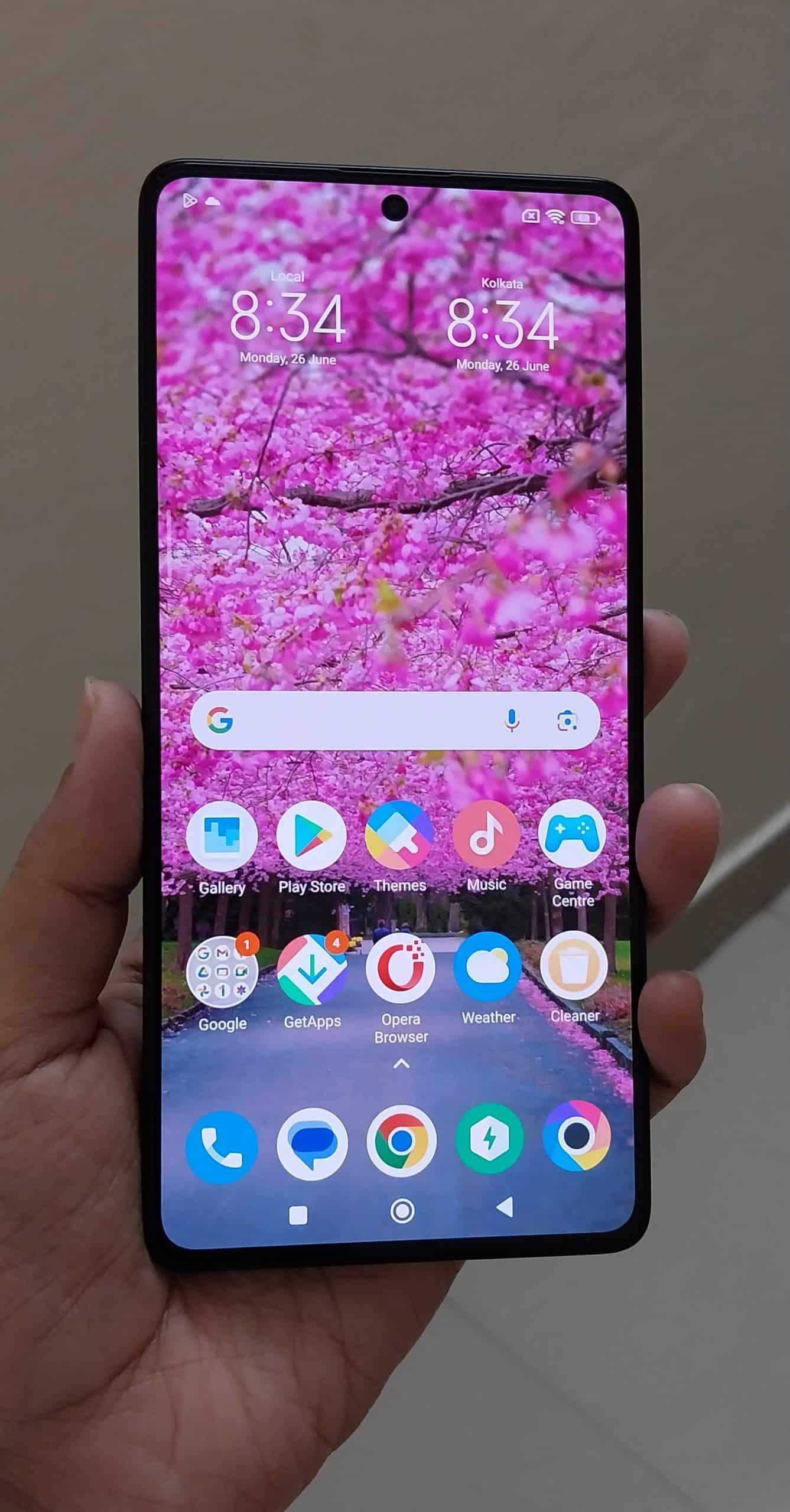
Now, while we were using the phone, we discovered that Poco has something called adaptive HDR on the display that senses the ambient light and then tunes the highlights and the shadows accordingly. This ensure that if the light is very high then the brightness also goes higher.
In our time with the Poco F5, this worked exceptionally well. It was especially good at controlling the highlight peaks when we tried watching content in the dark. The visuals look extremely good because of this.
Also the colour gradation is quite smooth with 100 per cent DCI-P3 colour gamut support as well.
Adding to an already great display is a set of stereo speakers with Dolby Atmos in the mix and you have really good multimedia experience in Poco F5.
Poco F5 – Hardware, Software and Performance
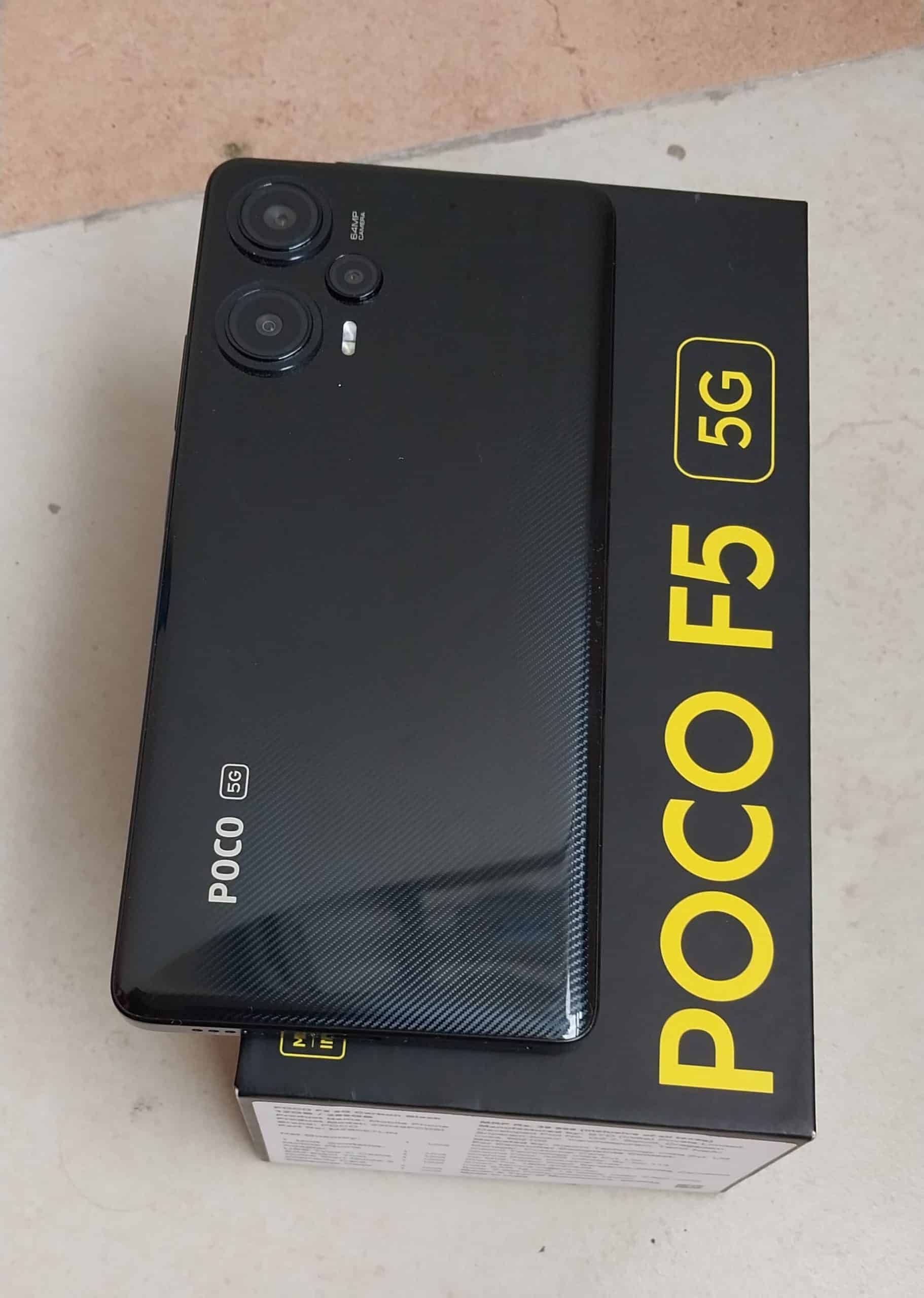
Let’s start with the hardware.
As soon as we got to know that Poco F5 is using the Snapdragon 7+ Gen 2 chipset, we were reminded of how similar this 7 Series chip performance is to an 8 series chip.
The 7+ Gen 2 chipset basically has the same phone animator fabrication process as can be seen in the Snapdragon 8+ Gen 1 chipset.
Both the chips also have a very similar 1+3+4 core architecture. The only major difference between the two chipsets is that 8+ Gen 1 has a higher clock speed.
Now, if we compare the Snapdragon 7+ Gen 2 processor with the processor we usually get in the smartphone of this price segment, the Poco F5 clearly scores well. Most phones in this price category use the MediaTek Dimensity 8200.
Looking at the AnTuTu and Geekbench 6 scores of both processor, 7+ Gen 2 easily scores more than the Mediatek Demensity 8200.
Those of you who are interested in benchmark scores, the next section is for you all. We tried to conduct every test possible and got some intresting results that you can find the screenshots below.
Interestingly, the Benchmark scores you can see above are pretty much close to the ones that many reviewers got for their tests on the higher variant the Poco F5 Pro, which comes with the Snapdragon 8 Gen 1 chipset.
As for the software, Poco F5 runs on MIUI 14 based on Android 13 and it offers a two years of software updates and three years of security updates as well.
Now, although the question of liking the software is pretty subjective, our overall experience with MiUI 14 has been decent enough. We particularly like the animations. And it has also got a lot of features that keeps the overall experience unique and interesting.
However, Poco does gives us a reason to complain as the problem is that it is filled with a lot of unnecessary bloatware apps.
It comes with many unwanted game apps that can make the entire process of getting rid very annoying.
In all honestly, we don’t see a reason why Poco needs to add all these bloatware in 2023, especially when they are trying to provide flagship experience.
Adding to the annoyance of bloatware is also the constantly popping-up of advertisement when you open the app drawer. We really wish Poco, a lot of other brands, now stop doing this with their mid to high range smartphones.

Now, if you are gamer, you would want to know how Poco F5 fares in the gaming department.
To test the gaming capability of the phone, we tried running those graphic heavy games such as Asphalt 9 and Call of Duty Gaming mobile version.
In our experience, we haven’t encountered any issues although mostly we were running the games on medium settings.
However, when we tried bumping the games up to highest graphic settings available, we were pleasantly suprised with the results.
The Poco F5 handled higher settings in this games pretty well. There may be some frame drops from time to time, but it is barely noticeable.
One thing to note is that the Poco F5 does feel a little bit warm to the touch when playing games or even doing some heavy multitasking for a prolonged period of time. Although for many users, this is quite subjective and can be considered normal for gaming phones.
The display has a touch sampling rate of 240Hz, which makes it very responsive to touches and works in the favour of gamers. Then, also adds up is the flat display, UFS 3.1 storage, LPDDR5 RAM, all together ensure you get really smooth performance in daily usage.
We didn’t encounter any immediate issues or lags when using this device as our main device for a couple of days.
The Poco F5 impressively handled all everyday smartphone activities we tried, starting from basic social media and browsing web to editing videos or raw images in third-part editing apps.
Poco F5 – Camera Configuration
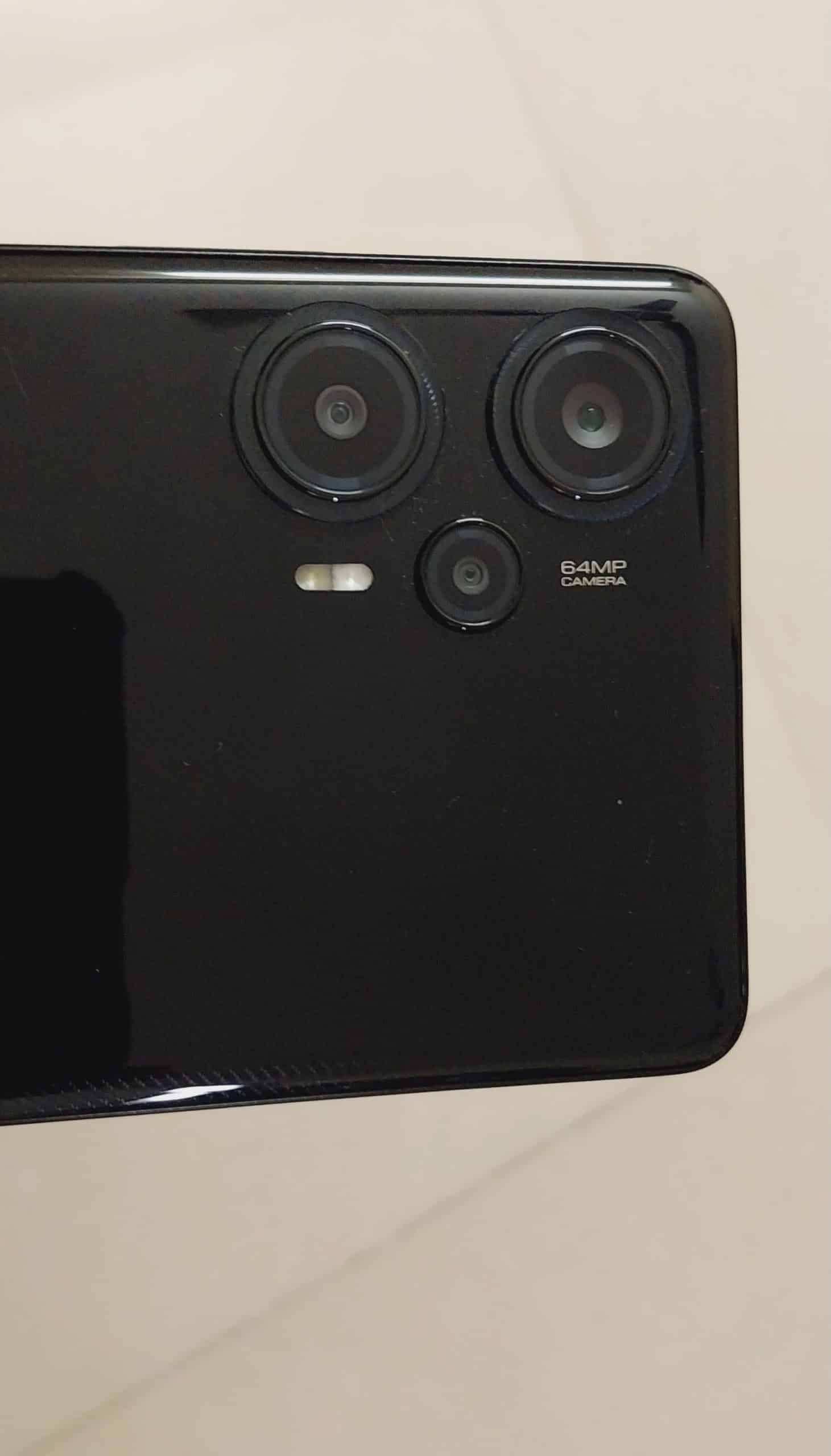
Now, when everything is going great for Poco F5, we were no doubt a little disappointed with the cameras after thoroughly using the camera setup in different lighting and angles.
The primary 64-megapixel camera uses an omnivision OV 654B sensor and there’s also an Optical image stabilization. When we tried using the main lens, the results remain inconsistent.
Although, it managed captures fairly detailed shots in daylight, the colours were almost always not very accurate.
The camera also evidently struggles while using for indoors photography.
Then, coming to other features, the HDR performance was also not that great. The highlights are blown out and during group pictures, skin tone inaccuracy was easily noticable. The portraits too have poor edge cutouts.
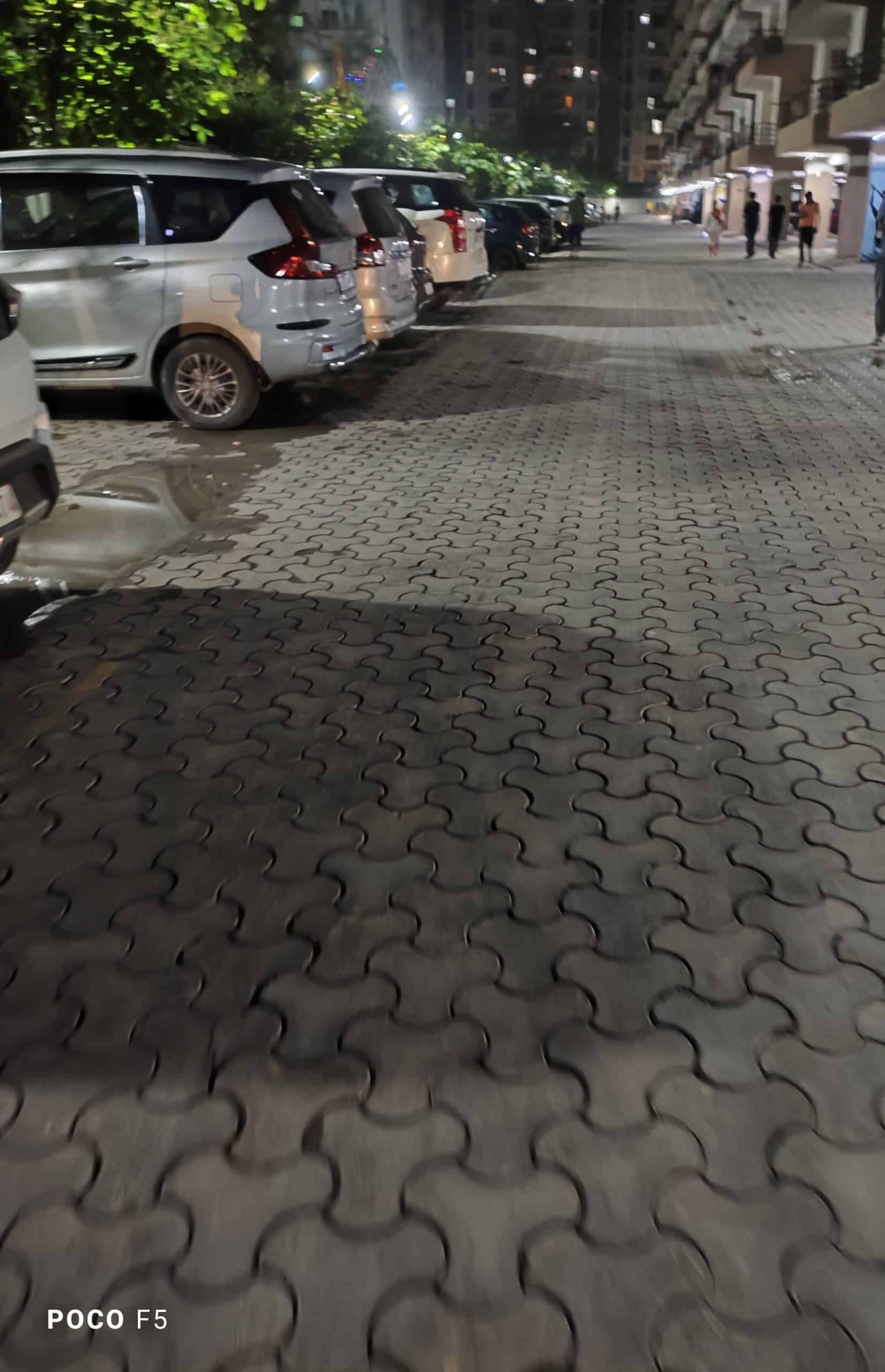
We tried shooting moving subjects and the pictures generally come out blurry as can be seen in the above samples. This could be because of slow shutter response.
As for the low light night mode shots, the results were not too bad but they are definitely not great either.
Here’s a bunch of sample shots taken at different time of the day from different angles to get a fair idea of the camera performance.
The camera performance more often than not is average at best. The main lens can’t pull out too many details from the darker portions of the image. Even the 16-megapixel selfie cameras captures more details.
One thing we noticed about the selfie camera though, it captures images a little to brighter despite switching off the beauty mode.
Now, we also tried to shoot some videos using the primary camera in different time of the day and the results were decent. However, video shot at night was inconsistent and extremely shaky with noticeable frame drops.
Here is a street video shot at night
You can shoot 4K 30FPS videos using the primary camera. While shooting in the bright daylight, we did notice that the footage gets a little blown out. However, the quality of videos shot outside in bright daylight was much better than any videos shot otherwise.
Here is the daylight video shot using the POCO F5 during the day-
The front camera can shoot 1080P 60FPS video and it is not limited to 30 FPS, which is definitely a good thing for users who use their device for social media reels or even work related video calls.
Now, overall when it comes to the camera quality, the output here is pretty average for the segment its is catering to. We today have many mid-range smartphones in the market with exceptional camera configuration that mirror results of professional cameras.
The camera in Poco F5 struggles in dark environment as both the main camera and the ultra wide lens sometimes fail to capture the right colours of the subject or producing detailed images.
All in all, camera of Poco F5 under underwhelming considering the price bracket it falls under.
Poco F5 – Battery Life and Connectivity
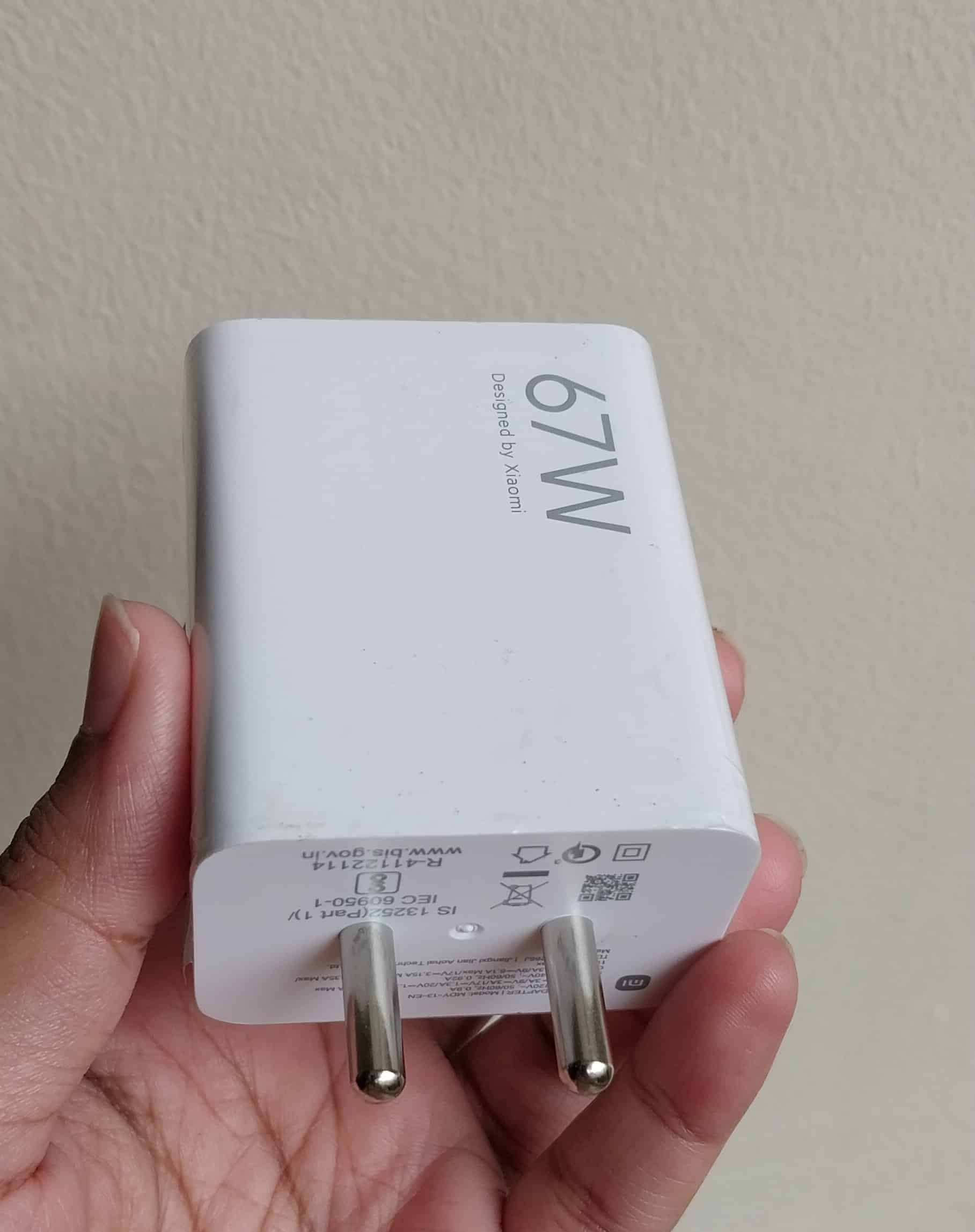
Now, what about battery life of Poco F5? Does the 7+ Gen 2 chipset good at power efficiency? Let’s try to find out.
With its massive 5000mAh (typ) battery capacity, you can expect impressive longevity with Poco F5. We used the phone for a whole day on a single charge and it was enough to go through the day without constantly worrying about recharging.
We use the phone with its default automatic refresh rate setting and got a decent on-screen time of about 7 hours. Now, of course, if you indulge in gaming for long hours, this would vary.
What truly sets the Poco F5 apart is its lightning-fast charging capabilities. The phone supports 67W turbo charging, which means you can quickly replenish the battery and get back to using your smartphone in no time. The included 67W in-box charger ensures you have the necessary equipment to take full advantage of this rapid charging feature.
We tried to test this by draining the battery of F5 to 1 per cent. Once on charging, it took the turbo charger about 42 minutes to get the device from 1 per cent to more than 95 per cent.
As for connectivity, the phone supports every 5G band that one might need to operate 5G service in India. So, the n77 the n78 5G bands are present. This means, the Airtel and Jio 5G work exceptionally well on Poco F5.
Verdict
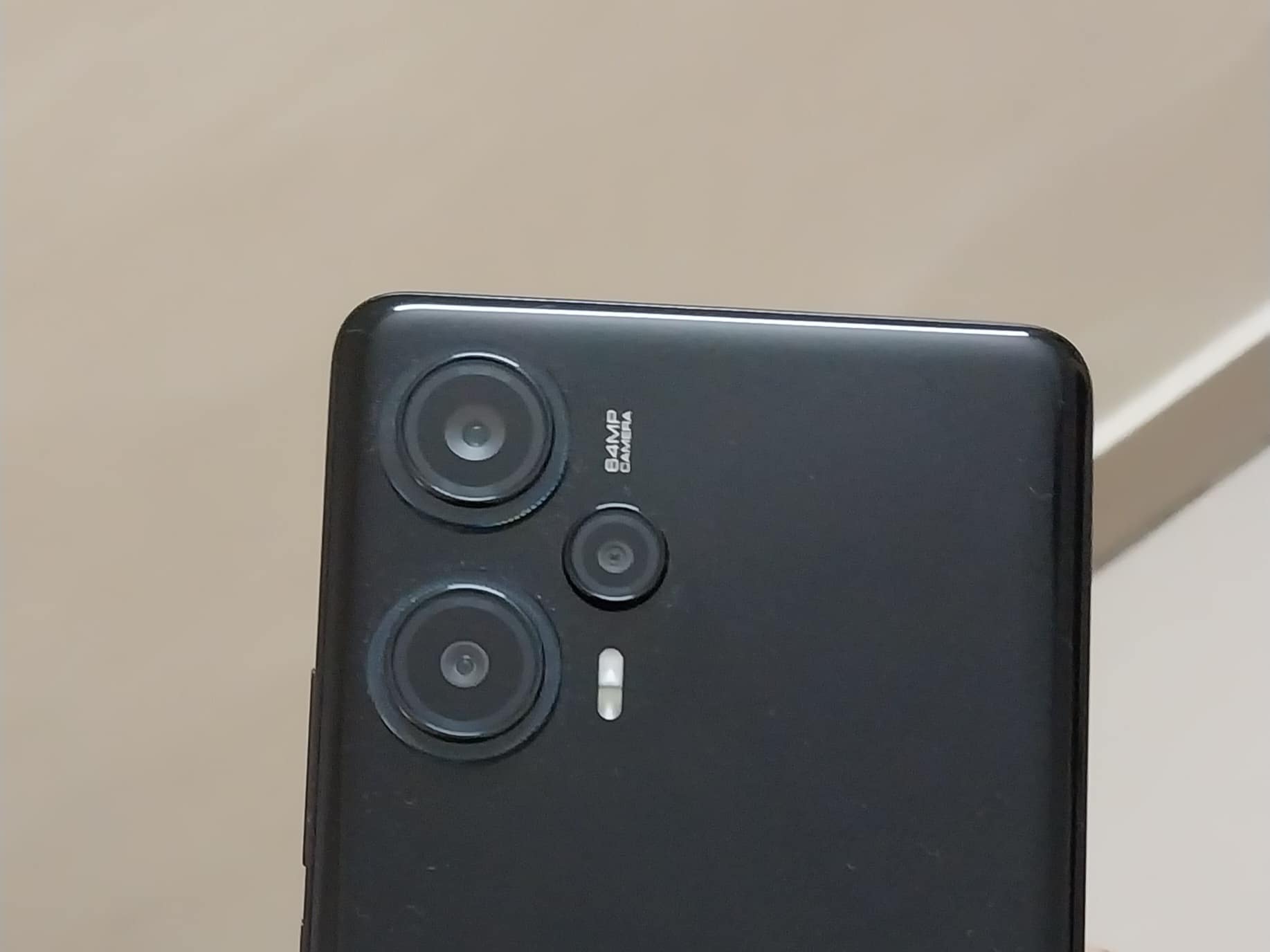
The Poco F5 scores really well in three departments – the display, the processor and the pricing. Basically, you are gettting a perfect mid-range gaming phone under 30K with absolutely no compromise on the performance and the display.
In this price category, there shouldn’t be any doubts that the F5 has managed to offer the best performance and the best display.
Now, all this automatically makes the Poco F5 the best smartphone for gamers at this price.
It is also a suitable device for those of you who use their smartphone primarily for streaming various content as let’s not forget the great stereo speakers you are getting along with a 3.5mm headphone jack that has become a rarity lately.
However, Poco F5 is not without flaws. The major problem that we also mentioned above is in the camera department. The camera performance is average at best.
And thus, if you are looking for a camera oriented phone then the Poco F5 is not the option we would recommend to you.
Buy Poco F5 For
- Flagship eye care experience
- Snapdragon® 7+ Gen 2 processor
- Excellent 120Hz Flow AMOLED display with super slim bezel
- LiquidCool Technology 2.0 for heat dissipation
- 5000mAh Battery with 67W turbo charging
- Dual Speakers (Dolby Atmos)
Poco F5 – My Mobiles Rating
Design – 3/5
Display – 4/5
Performance – 3.5/5
Camera – 2.5/5
Battery – 4/5
Overall – 3.5/5
Poco F5 – Price and Avaibility
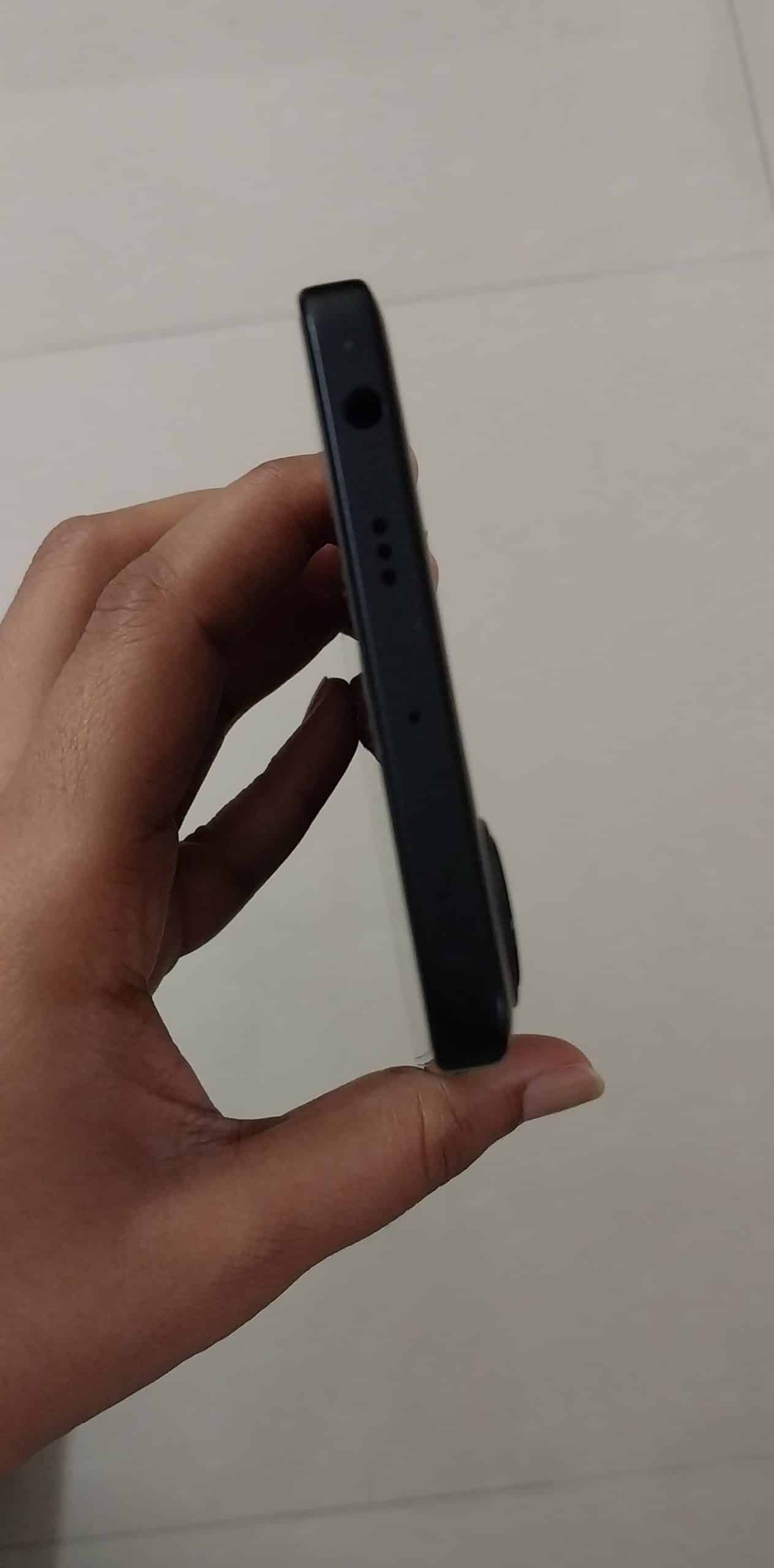
POCO F5 price in India starts from Rs. 29,999 for the base variant. This is 8 GB RAM / 256 GB internal storage base variant of POCO F5 which is available at the lowest price exclusively at Flipkart.com.
POCO F5 is available in three colour variant that includes a Carbon Black, Sandstorm White, Electric Blue colour options.
Poco F5 – A Comparison With Other Phones in the Segment
| Overview | Poco F5 | Xiaomi Redmi Note 12 Pro 5G | POCO F3 GT |
| Performance | Qualcomm Snapdragon 7 Plus Gen 2
8 GB RAM |
MediaTek Dimensity 1080 MT6877V
6 GB RAM
|
MediaTek Dimensity 1200 MT6893
6 GB RAM
|
| Display | 6.67 inches
AMOLED, Dolby Vision, HDR 10+
|
6.67 inches
AMOLED, 2.5D Curved Glass, Dolby Vision, HDR 10+ |
6.67 inches
AMOLED, HDR 10+
|
| Rear Camera | 64 MP + 8 MP + 2 MP | 50 MP + 8 MP + 2 MP | 64 MP + 8 MP + 2 MP |
| Front Camera | 16 MP | 16 MP | 16 MP |
| Battery | 5000 mAh
Turbo 67W Fast charging |
5000 mAh
Turbo 67W Fast charging |
5065 mAh
Sonic v3.0 67W Fast charging |
| Water Resistant | Yes, Splash proof, IP53 | Yes, Splash proof, IP53 | Yes, Splash proof, IP53 |
| Operating System | Android v13 | Android v12 | Android v11 |
| 5G | Yes | Yes | Yes |
| Price | ₹ 29,999 | ₹ 23,186 | ₹ 32,999 |
POCO F5 KEY SPECIFICATIONS
Key Specs
| RAM | 8 GB |
| Processor | Qualcomm Snapdragon 690 |
| Rear Camera | 64 MP + 8 MP + 5 MP |
| Front Camera | 32 MP |
| Battery | 4700 mAh |
| Display | 6.7 inches (17.02 cm) |
General
| Launch Date | April 3, 2023 (Unofficial) |
| Operating System | Android v12 |
Performance
| Chipset | Qualcomm Snapdragon 690 |
| CPU | Octa core (2 GHz, Dual core, Kryo 560 + 1.7 GHz, Hexa Core, Kryo 560) |
| Architecture | 64 bit |
| Fabrication | 8 nm |
| Graphics | Adreno 619L |
| RAM | 8 GB |
Display
| Display Type | Super AMOLED |
| Screen Size | 6.7 inches (17.02 cm) |
| Resolution | 1080 x 2400 pixels |
| Pixel Density | 393 ppi |
| Screen Protection | Corning Gorilla Glass v5 |
| Bezel-less display | Yes with punch-hole display |
| Touch Screen | Yes, Capacitive Touchscreen, Multi-touch |
| Refresh Rate | 120 Hz |
Camera
| MAIN CAMERA | ||
| Camera Setup | Triple | |
| Resolution | 64 MP f/1.8, Wide Angle, Primary Camera 8 MP f/2.2, Ultra-Wide Angle Camera 5 MP f/2.4 |
|
| Autofocus | Yes | |
| Flash | Yes, LED Flash | |
| Image Resolution | 9000 x 7000 Pixels | |
| Settings | Exposure compensation, ISO control | |
| Shooting Modes | Continuous Shooting High Dynamic Range mode (HDR) |
|
| Camera Features | Digital Zoom Auto Flash Face detection Touch to focus |
|
| Video Recording | 1920×1080 @ 30 fps | |
| FRONT CAMERA | ||
| Camera Setup | Single | |
| Resolution | 32 MP f/2.45, Primary Camera | |
| Video Recording | 1920×1080 @ 30 fps | |
Battery
| Capacity | 4700 mAh |
| Type | Li-Polymer |
| Removable | No |
| Quick Charging | Yes, Sonic, 67W |
| USB Type-C | Yes |
Storage
| Internal Memory | 128 GB |
| Expandable Memory | No |
Network & Connectivity
| SIM Slot(s) | Dual SIM, GSM+GSM |
| SIM Size | SIM1: Nano, SIM2: Nano |
| Network Support | 5G Not Supported in India, 4G Supported in India, 3G, 2G |
| VoLTE | Yes |
| SIM 1 |
4G Bands:
TD-LTE 2300(band 40)
FD-LTE 1800(band 3) 3G Bands:
UMTS 1900 / 2100 / 850 / 900 MHz
2G Bands:
GSM 1800 / 1900 / 850 / 900 MHz
GPRS:
Available
EDGE:
Available
|
| SIM 2 |
4G Bands:
TD-LTE 2300(band 40)
FD-LTE 1800(band 3) 3G Bands:
UMTS 1900 / 2100 / 850 / 900 MHz
2G Bands:
GSM 1800 / 1900 / 850 / 900 MHz
GPRS:
Available
EDGE:
Available
|
| Wi-Fi | Yes, Wi-Fi 4 (802.11 b/g/n) |
| Wi-Fi Features | Mobile Hotspot |
| Bluetooth | Yes, v5.3 |
| GPS | Yes with A-GPS, Glonass |
| NFC | Yes |
| USB Connectivity | Mass storage device, USB charging |
Multimedia
| Loudspeaker | Yes |
| Audio Jack | USB Type-C |
Sensors
| Fingerprint Sensor | Yes |
| Fingerprint Sensor Position | Side |
| Other Sensors | Light sensor, Proximity sensor, Accelerometer, Compass |
FAQs
Q1. What is the display size and quality of the Poco F5?
Answer. The Poco F5 features a 6.67-inch FHD+ Flow AMOLED DotDisplay, offering vibrant colors and sharp visuals with a resolution of 2400 x 1080.
Q2. Does the Poco F5 support fast charging?
Answer. Yes, the Poco F5 supports 67W turbo charging, allowing for rapid recharging of the device’s 5000mAh battery.
Q3. What is the camera setup on the Poco F5?
Answer. The Poco F5 comes with a triple rear camera setup, consisting of a 64 MP primary lens, an 8 MP ultra-wide lens, and a 2 MP depth sensor, ensuring stunning photos and videos.
Q4. Which operating system does the Poco F5 run on?
Answer. The Poco F5 runs on the Android operating system, specifically the Android v13, providing a user-friendly interface and access to a wide range of apps.
Q5. Does the Poco F5 have expandable storage?
Answer. Unfortunately, the Poco F5 does not have expandable storage. However, it offers ample internal storage of 256 GB, allowing for plenty of space for your files, apps, and media.
Q6. What are the processor capabilities of POCO F5 5G?
Answer. POCO F5 5G debuts the Snapdragon® 7+ Gen 2 in India, which is the most powerful processor in the Snapdragon 7-series to date and has a similar architecture to the Snapdragon® 8+ Gen 1.
Q7. What is the AnTuTu score of POCO F5 5G?
Q8. What is Hyperboost Gaming?
Q9. What is Xfinity Pro AMOLED Display on POCO F5 5G?
Q10 What is PWM Dimming in POCO F5 5G?
Q11. Does POCO F5 5G support Dolby Vision?
Q12. What is a 120Hz Adaptive Refresh Rate on POCO F5 5G?
Q13. How much time does the POCO F5 5G take to charge?
Q14. What are the camera capabilities of the POCO F5 5G?
Q15. What is OIS?
Also Read: Poco F5 5G India launch today: Expected price and specs, timing & how to watch livestream
Also Read: POCO F5 RAM, storage, and colour options officially confirmed ahead of May 9th launch

